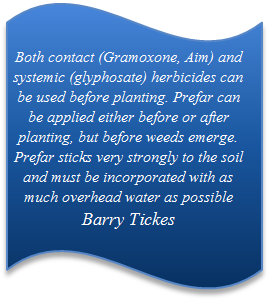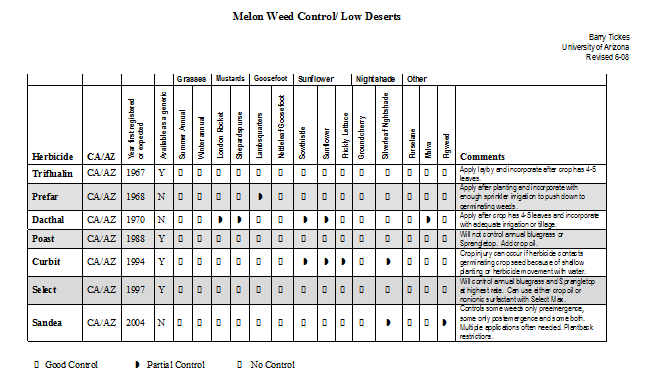
The list of herbicides available for use in melons is very limited. Fortunately,
most of the types of melons produced here grow rapidly and nonchemical weed control
practices like cultivation and plastic mulch can be effective. Shallow cultivation
and nonselective herbicides with no soil activity can be effective if used after
bed formation and before planting. Both contact (Gramoxone, Aim) and systemic (glyphosate)
herbicides can be used. Prefar can be applied either before or after planting, but
before weeds emerge. Prefar sticks very strongly to the soil and must be incorporated
with as much overhead water as possible. It does not work well when drip or furrow
irrigation are used. Curbit (Ethafluralin) can be effective but will cause crop
injury if it is concentrated around the germinating melon seed by water or cultivation.
There are more herbicide options after the crop has emerged and developed three
or four leaves. Dacthal and Trifluralin can be used as layby applications before
weeds have emerged. Both can cause unacceptable stunting of the crop if applied
too early. Prowl is not safe to melons at normal use rates and is not registered.
Sandea is registered and can be effective on nutsedge and several broadleaf weeds.
It is safe to most melon types after they have four leaves and before blooming.
Carryover in the soil is a consideration if sensitive crops are to follow. The grass
herbicides, Select, Select Max, Poast, and generics of these, are registered and
effective on most grasses. Poast will not control sprangletop or annual bluegrass,
but the highest rates of Select, Select Max, and generics of Clethodim are. Temporary
crop injury from Select Max can occur where the sprayer overlaps or slows down at
the end of rows. This normally only occurs where a 2x or greater rate is applied.





